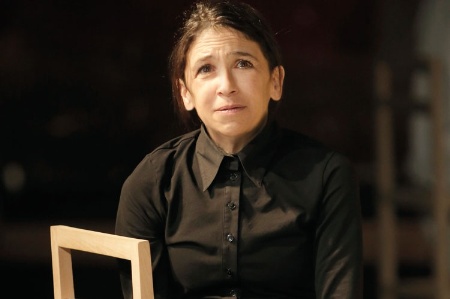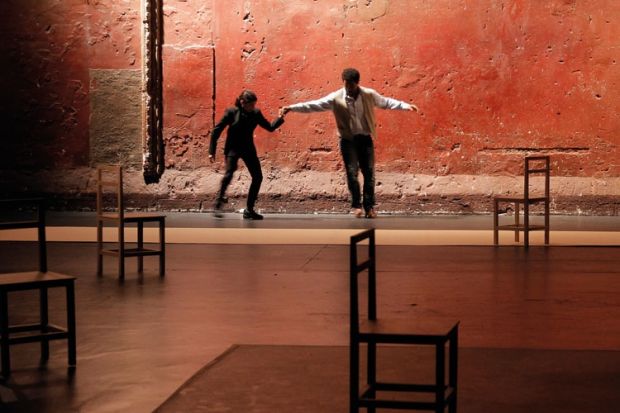Source: Pascal Victor
Tricks of memory: Kathryn Hunter plays Sammy Costas, a woman who has an exceptional talent for remembering things, in Peter Brook’s new play at the Young Vic
The Valley of Astonishment
Directed by Peter Brook and Marie-Hélène Estienne
Starring Kathryn Hunter, Marcello Magni and Jared McNeill
Young Vic, London, 20 June-12 July 2014
The play is fascinated by whether Costas’ condition is blessing or curse, whether she can live a normal life or become a performing ‘phenomenon’
Perhaps Britain’s most distinguished theatre director, the 89-year-old Peter Brook has long been interested in extreme mental states, and the light they throw on the “normality” of the rest of us.
One of his breakthrough productions was of Peter Weiss’ Marat/Sade – full title: The Persecution and Assassination of Jean-Paul Marat as Performed by the Inmates of the Asylum of Charenton Under the Direction of the Marquis de Sade – in 1964. His landmark version of A Midsummer Night’s Dream used Frisbees, spinning plates, trapezes and other circus techniques to convey the dizzying emotions of desire and love. And in 1993, already based in Paris, he adapted some of the startling neurological case histories in his friend Oliver Sacks’ The Man Who Mistook His Wife for a Hat as L’Homme Qui.
He describes this now as “our first adventure into the labyrinths of the brain”, where “we met neurological cases who in the past had been conveniently written off as ‘mad’. Our first surprise was to encounter beings like ourselves…”
At one stage in his career, Brook was famous for vastly spectacular productions such as The Conference of the Birds (1979), based on a 12th-century Persian epic. He has since turned often to a much more stripped-down approach, taking classic plays and operas – Hamlet, Carmen, The Magic Flute – and trying to get back to their emotional core. His method in staging a play, he recently told an audience at the Warwick Arts Centre, was to “start with a lot of cluster, to avoid a cold, puritanical vision, and then let natural elimination lead you to the few things you really need”. Elaborate props, costumes and scenery often prove more distraction than help.
Brook has long-term links with the arts centre, situated on the campus of the University of Warwick. Its director, Alan Rivett, was among those whose life was changed by seeing A Midsummer Night’s Dream, with its “simple white box setting full of psychological complexities; truly Shakespearean, but very modern; a playground that was somehow cruel; fourth-wall conventions that also fused action and audience”. His theatre has therefore taken in many of the productions Brook has mounted at the Théâtre des Bouffes du Nord in Paris, starting with Le Costume in 2001. The Valley of Astonishment spent four days in Warwick before transferring to London’s Young Vic for its main run. Warwickshire is Shakespeare country, Brook reflected, and his philosophy was to adopt “the Elizabethan principle of using humour and laughter to take you step by step towards intensity”.

The Valley of Astonishment draws together many of these earlier concerns. Although Brook claimed he was “not interested in labels and definitions” when someone in the post-show audience asked about “science plays” and “science art”, it is built round the story of a medical phenomenon, a woman called Sammy Costas (regular Brook collaborator Kathryn Hunter), who ranks among “the most eminent mnemonists described in the scientific reviews”.
Since she was a child, she has found that “syllables settled in [her] mind as puffs of steam or splashes” and she is able to remember even long lists of nonsense phrases by turning them into sharply visualised images in a landscape that she can then walk through. She imagines the number 7 as “a man with a moustache”, 8 as “a very fat woman – a sack within a sack”, so to recall 87 she only has to think of “the fat woman flirting with the man twirling his moustache”.
Costas discovers how unusual her talent is when the editor at her newspaper tells her off for not bothering to take notes and she amazes him by recounting every tiny detail of what happened in a meeting. So she goes for tests at a neuropsychology laboratory and tells the astonished doctors “I don’t have a trick, it’s like breathing. I encrust the words, the syllables, and they stay there for ever.” The only explanation, they conclude, is that she’s “a synaesthete”, someone whose “senses are mixed – two senses at the same time. For example: sound and colour, taste and shapes.”
In order to learn more about the strange phenomena of “coloured hearing”, “coloured taste”, “coloured smell” and other varieties of synaesthesia, Brook sought help from a leading expert, Simon Baron-Cohen, director of the Autism Research Centre at the University of Cambridge.
Although synaesthesia was the subject of active research in the 1880s, says Baron-Cohen, “it fell into disrepute in the 1920s, since people felt it couldn’t be studied scientifically. We wrote an early paper in 1987 suggesting that research should take it seriously again.” This led them to develop a definitive test for the condition, put people under scanners, look at whether there was a genetic element and whether it was associated with Asperger’s syndrome, as in the case of a man who was able to remember the value of pi to many thousand decimal places.
As well as explaining what science can now tell us about synaesthesia, Baron-Cohen was able to introduce Brook to an artist and musician called John Adams who was happy to talk about his experiences.

Many books by neurologists such as Oliver Sacks and Paul Broks explore the vexed question of the relationship between the physical brain and the subjective experience of the individual mind. We may be able to locate an ability, feeling or sensation in a particular region of the brain, in the sense that we know what happens if it gets damaged, but how far is such a correlation a real explanation? Can it not reduce all that makes us human and unique to lumps of meat and patterns of brainwaves?
Brook and Estienne’s new production is also fascinated by such issues, by whether Costas’ condition is a blessing or a curse, whether she can live a normal life or is forced to become a performing “phenomenon”. It also asks whether the doctors, through their tests and measurements, can provide any insights that might actually help her.
“It’s so easy to reduce a human being to details,” one reflects. “We’re only just beginning to see the neurones, the synapses and the cells are quite simply parts of a whole that we may never really understand.” When Costas proposes to donate her brain to their institute so they can “discover more about the secrets of the human brain”, they hardly seem keen to take her up on the offer.
While exploring these big philosophical themes through Costas and a couple of parallel cases, The Valley of Astonishment returns to the story of the phoenix and other material from Persian mythology Brook used in The Conference of the Birds. The main action is topped and tailed by a (borderline pretentious) narrative voice offering reflections such as “If you could see an entire world burnt away by fire, it would only be a dream compared with reality.”
In sharp contrast to this, the play also incorporates its own form of Shakespearean comic relief, parodying the serious treatment of memory in the main story through an inept, one-armed, Argentine magician, Salvador Salvado (Marcello Magni), who lures audience members up on to the stage and performs tricks rather in the style of Tommy Cooper.
After a lifetime of theatre-making, Brook has a sure instinct for evocative subject matter, an unerring ability to get to the emotional point and an effortless command of understated stagecraft. The Valley of Astonishment is hardly one of his most ambitious projects, but it certainly delivers on his continuing desire to surprise and amaze us.
Register to continue
Why register?
- Registration is free and only takes a moment
- Once registered, you can read 3 articles a month
- Sign up for our newsletter
Subscribe
Or subscribe for unlimited access to:
- Unlimited access to news, views, insights & reviews
- Digital editions
- Digital access to THE’s university and college rankings analysis
Already registered or a current subscriber? Login

